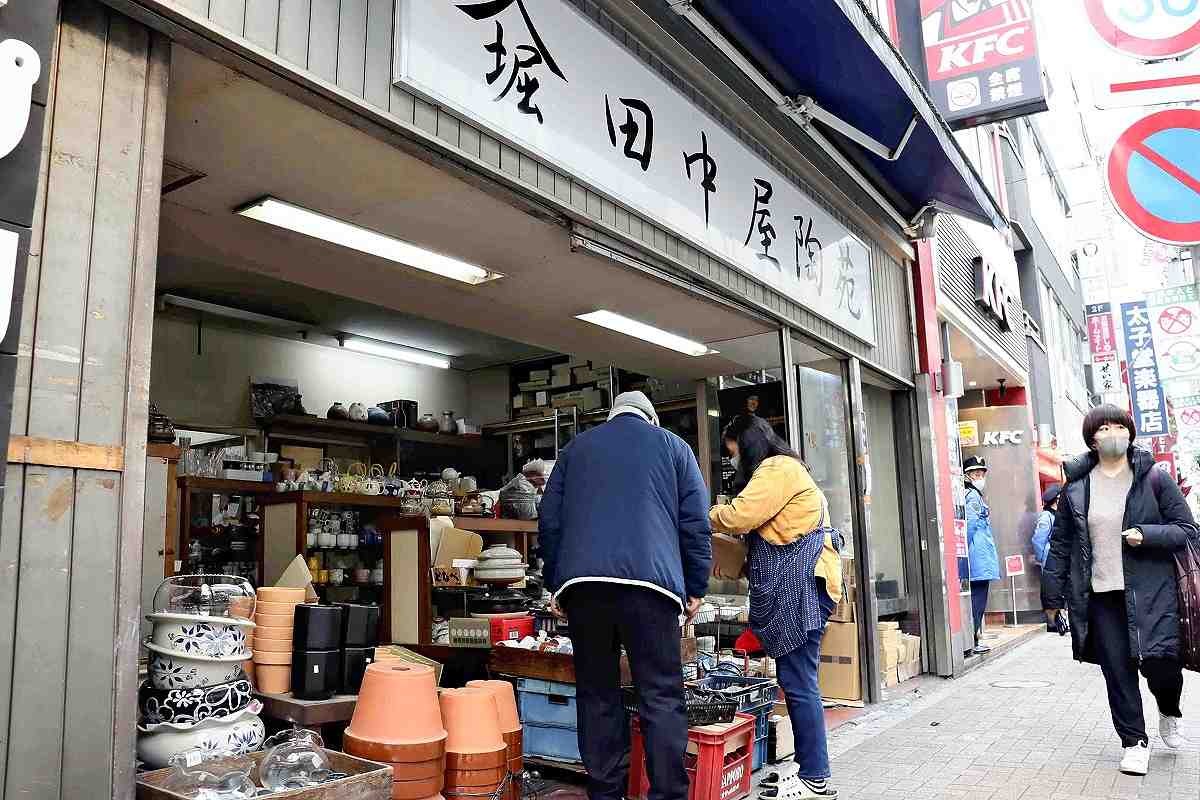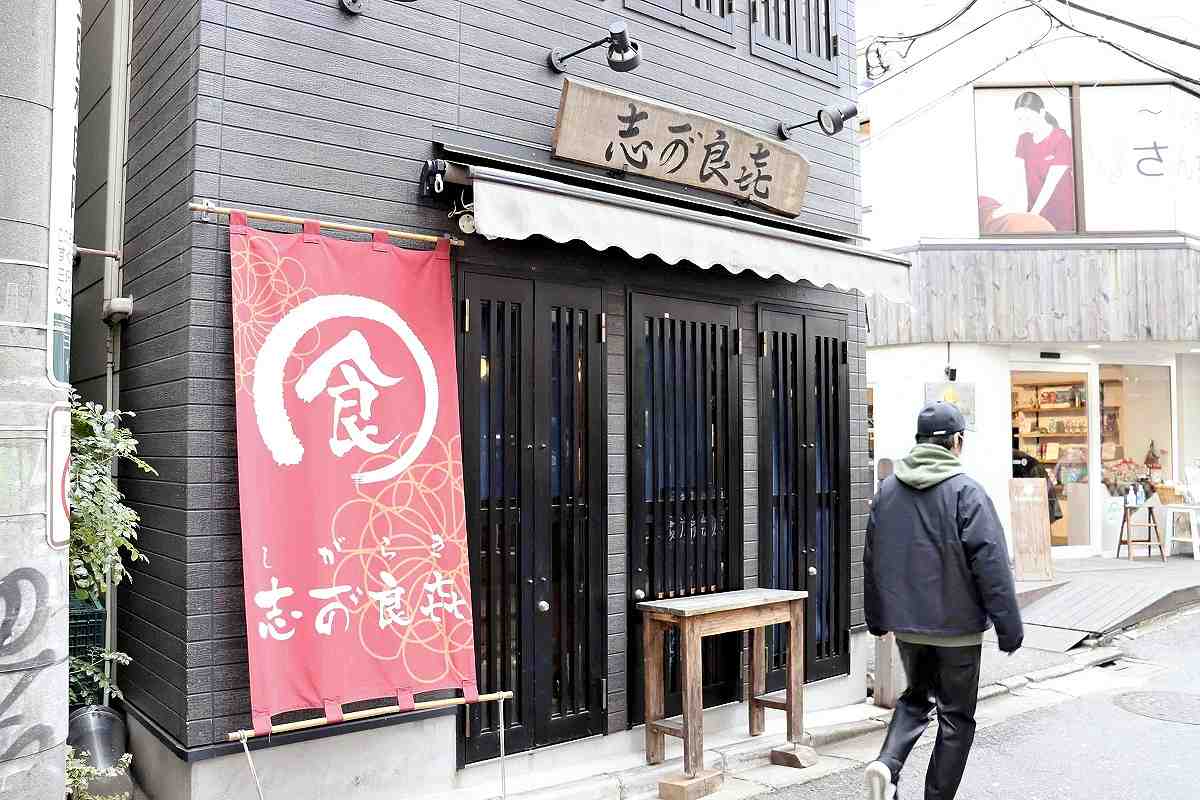
Tanakaya Toen, a pottery shop, which has maintained the Tanakaya trade name, is seen in Setagaya Ward, Tokyo.
14:43 JST, February 9, 2021
The Sangenjaya area in Setagaya Ward, Tokyo, is home to a shopping street with a quaint atmosphere alongside new and fashionable restaurants and eateries.
Sangenjaya’s name comes from the fact that there used to be three teahouses in the area. Establishments that are rooted in two of the teahouses still maintain their trade names despite changing their types of business.
The historical document “Shinpen Musashi Fudokiko,” which was compiled by the Tokugawa shogunate in the late Edo period (1603-1867), refers to the origin of the name Sangenjaya, according to the Setagaya Local History Museum. Musashi Province was part of present-day Tokyo and the prefectures of Kanagawa and Saitama.
“In the past, there were three houses in this place,” the document says. The three houses are said to be Tanakaya, Shigaraki and Kadoya, all teahouses located at an intersection of today’s Setagaya and Tamagawa streets. Of the three, Tanakaya continues currently as the Tanakaya Toen pottery shop.
I visited the shop, which is located just after entering Chazawa Street from the intersection.
According to Yukio Horie, 64, who operates Tanaka Toen, teahouses were resting places for travelers where tea and sake were served. People could also stay overnight at the teahouse Tanakaya. Horie said his grandfather told him that Hijikata Toshizo, a senior member of the Shinsengumi, a samurai force in the final years of the Edo period, had walked around this area. His grandfather started the pottery store around 1915.
According to a booklet about Setagaya, published by the Setagaya ward office in 1994, Tanakaya was used as a place for village officials to meet and discuss matters, such as the Namamugi Incident in 1862, in which Britons were killed or injured by samurai warriors during a daimyo procession in the turbulent years of the Edo period. At its peak, Tanakaya is said to have been as large as 1,000 tsubo (3,306 square meters).
“Even though our business has changed from being a teahouse, I hope we continue to keep the trade name and hand it down to future generations,” Horie said.
Resting area for pilgrims
According to Yasuhiko Mori, 86, a professor emeritus at the National Institute of Japanese Literature who is well versed in the history of Setagaya Ward, Sangenjaya flourished as a teahouse district because it served as a resting area for travelers making pilgrimages to Oyama Afuri Shrine in Isehara, Kanagawa Prefecture.
When Mori was a university student, he had a chance to review records of parishioners of Ensenji temple in Setagaya Ward to write his graduation thesis. According to Mori, the name Sangenjaya appears in 1766 and afterward in the records, which date back to the mid-17th century. This coincides with the 1750s, when pilgrimages to the shrine became popular.
Mt. Oyama was also known as the “amefuri” (rainy) mountain, and the shrine was the center of offering prayers for rain. In the Edo period, about 200,000 people visited the shrine every year. At that time, people are said to have spent several days walking to reach the shrine from Edo.
“As Sangenjaya is located at a three-way intersection, it must have been a good place to take a break,” Mori said.

A road marker erected in the late Ed period indicates that this was the trail for Mt. Oyama pilgrimages.
Shigaraki reborn as izakaya pub
Besides Tanakaya, Shigaraki is another teahouse-rooted business that remains today. It is now a Japanese izakaya pub that Tomohiro Hoshina, 41, opened in 2016 on the south side of the intersection. The location is near where the Shigaraki teahouse once stood.
One of Hoshina’s ancestors four generations ago was adopted by the Shigaraki family, and his grandmother ran a tempura restaurant at this place. Members of the main branch of the Shigaraki family no longer live in Sangenjaya. Hoshina started his own business after working for about 20 years at a kaiseki restaurant specializing in traditional Japanese cuisine.
On Hoshina’s business card, his izakaya is described as a “house that originates Sangenjaya.”
“My relatives of the main branch of [the Shigaraki family] also root for me. I want to protect the trade name that sprang back to life,” Hoshina said.

The exterior of Shigaraki, a Japanese izakaya pub, is seen.
Related Tags
"Features" POPULAR ARTICLE
-

Sanrio to Open Museum in Yamanashi Pref. Dedicated to Founder, Exhibits Include Hello Kitty, Other Characters
-

Autumn Foliage Surrounds Visitors to Tokyo’s Showa Kinen Park
-

My Daughter No Longer Speaks to Me, But I Want to See Her and My Grandchild
-

Kumamoto: Public Bath Refurbished as Library Where You Can Chat, Take Photos
-

Frozen Vegetables: Demand Rises for Convenient, Tasty Domestic Produce
JN ACCESS RANKING
-

Keidanren Chairman Yoshinobu Tsutsui Visits Kashiwazaki-Kariwa Nuclear Power Plant; Inspects New Emergency Safety System
-

Imports of Rare Earths from China Facing Delays, May Be Caused by Deterioration of Japan-China Relations
-

Tokyo Economic Security Forum to Hold Inaugural Meeting Amid Tense Global Environment
-

University of Tokyo Professor Discusses Japanese Economic Security in Interview Ahead of Forum
-

Japan Pulls out of Vietnam Nuclear Project, Complicating Hanoi’s Power Plans


























